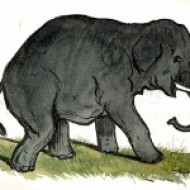
Welcome to 31 Days of Homemade Music! This month we are exploring how and why everyone can benefit from being an active participant in music making. To read more posts in this series, click here.
I could go on for a long time giving you resources and mini-lessons, but the purpose of this series is to encourage anyone and everyone to participate in music making. Naturally, listening and creating are closely related in the musical realm. We talked a bit about listening to unfamiliar music earlier in the series, and now I want to return to and zero back in on the idea of actively listening.
The first piece of music that I will give you as a listening “assignment” is Peter and The Wolf. Written by Serge Prokofiev in 1936, it was meant to be a children’s introduction to the orchestra. A charming folk tale by the composer himself gets set to music, with each character being represented by a corresponding instrument and musical theme. Young Peter gets the violins playing a heroic and playful tune; Grandfather gets the cranky old, chiding bassoon; the wolf gets an ominous French Horn theme. You can visit Phil Tulga’s site to read the story and hear all of the themes separately. You can watch the whole performance (including narration) in its entirety here:
This music is delightful for young children, but it is also very pleasant for adults to listen to. (My son inspired me to link to this because he was so enthusiastic after hearing it on the radio in the car yesterday.) You will enjoy hearing the recurring themes of different characters pop up in different parts of the story, and will soon be able to pick out which theme is which rather quickly.
Little did you know, these recurring themes provide a wonderful foundation for active listening. Try listening to a completely different piece of music later on and see if you can pick out other musical themes- a melody that gets repeated throughout the piece, a rhythmic motive that keeps popping up, etc. Peter and the Wolf engages you with a story, but preps you for hearing other pieces more intentionally as well.
Suggested listening activities for children (and adults too!):
- Identifying which theme fits which character
- Listen for variations of the themes
- Identifying instruments by sound
- Finding ways to imitate the sounds of the themes with household instruments (i.e., whistling for the bird, paper-towel-roll-horns for the wolf, big booms for the hunters’ drums, etc.)
- Creating a motion for each character that you do together whenever you hear the character’s theme (i.e., slinking cat, waddling duck, creeping wolf, marching Peter, etc.)
- Act out the story as you listen, or create a puppet show doing the same.
Do you love Peter and the Wolf? Snag your own CD copy here, or watch an animated version without narration here
(free if you have Amazon Prime). It should be noted that this version is darker than the typical pastoral cartoon version, and has a few moments that may be frightening for very young children. That being said, it is beautifully done and portrays wordless, yet powerful thematic elements for older viewers too. Happy listening!
This post contains affiliate links. If you click on the links and make a purchase, I will receive a small commission at no extra cost to you. Thank you in advance for your support!


